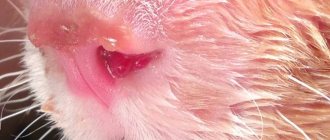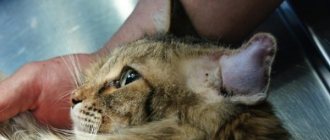Reasons why a cat bleeds from under its tail
Blood may come from an animal's anus and from a cat's vagina. In some cases this is not a pathology. Females reach puberty and begin estrus between 6 months and 1 year of age. Bloody discharge mixed with clear mucus is observed for 5-15 days, sometimes a little longer (depending on age and breed). During this period, the cat is attracted to the cat and they must mate. As soon as conception occurs, estrus stops. Cats that give birth go into heat on average 2 times a year. If the pet is not mated, then the cycles will be more frequent - every 2-3 months.
Bloody discharge from the vagina occurs in cats after birth, for 1-3 weeks and is also considered normal. If pus is mixed into the blood or there is too much discharge that the cat does not have time to lick itself, this is already a disease. A kitten may also start bleeding. Pathological reasons why an animal bleeds from the vagina:
Frozen pregnancy (the fetus dies and inflammation begins).- Endometriosis. Infectious lesions or hormonal imbalances cause inflammation in the uterus.
- Pyrometer. Purulent inflammation. Pus and blood accumulate in the uterine cavity. In the closed form of the disease, when the discharge remains inside, the consequences are very severe.
- Vaginitis. Inflammatory processes of various etiologies occurring in the vaginal area.
- Geometra. Accumulation of blood in the uterus caused by injury or disease of an inflammatory or hormonal nature.
When blood discharge from a pet's genitals is not caused by estrus or the postpartum period, urgent veterinary consultation and diagnostic examination are necessary. The described diseases require immediate treatment prescribed by a specialist.
Most common causes of bleeding
Normally, no blood should appear from the cat's anus during defecation. Owners may find blood on the tail, sleeping area, and in the pet’s feces when cleaning the litter box.
In young females, blood may gradually flow not from the butt, but from the vagina as a result of spontaneous abortion. Light bleeding is also normal for 1–3 weeks after birth.
If your cat starts bleeding from the anus not during the postpartum period or during estrus, you should immediately contact the nearest clinic. This symptom usually indicates the development of serious pathologies.
Poor quality feed or diet change
One of the common causes of bleeding from the anus is considered to be feeding mustachioed pets with low-quality food such as Whiskas or Kitekat. Veterinarians prohibit the introduction of such foods into the diet of cats, since they always lead to the development of various gastrointestinal diseases, which often end in the death of the animal. If owners want to feed their pet industrial food, they must choose a high-quality premium or super-premium product from trusted manufacturers.
Sometimes blood from a cat’s anus appears due to a sudden change in diet, when it is switched from natural food to ready-made food or vice versa. This transition usually leads to indigestion and, as a result, diarrhea with a very unpleasant odor and uncharacteristic color, interspersed with blood and mucus. Upon returning to the cat's usual menu, all these symptoms disappear.
Helminthiasis
When a cat is infected with helminths, a small amount of blood and mucus can be found in its feces. The pet also exhibits the following symptoms:
- vomit;
- loss of appetite;
- weight loss;
- “riding” on the butt;
- deterioration in wool quality;
- weakness.
The appearance of one or more of the above symptoms in a cat is a reason to consult a doctor as soon as possible. This is especially true for owners of kittens, because in them parasites cause serious deviations in the functioning of vital organs, and in the most advanced cases they will even lead to death.
Constipation
With constipation, blood discharge from the cat's anus occurs quite often, but its amount is usually insignificant. It is not difficult to understand that your pet is constipated - during the act of defecation, he meows loudly in pain, trembles and arches his back. In this case, the feces will be very hard, sometimes mixed with blood.
Constipation can be caused by an incorrect diet or the accumulation of a large number of hairballs in the stomach, which are formed during licking. To relieve constipation, it is allowed to use Duphalac, Vaseline oil or another laxative once.
Diseases of the gastrointestinal tract
There are many gastrointestinal diseases that lead to the appearance of blood from the cat's anus. The color of the discharge will help the owner understand in which part of the digestive system or intestines the disease is localized. Thus, a bright red color of blood indicates damage to the anus, a dark, almost brown color indicates problems in the upper gastrointestinal tract. However, a doctor must make a diagnosis and provide qualified assistance. Typically, cats are diagnosed with the following diseases of the gastrointestinal tract:
Colitis
Inflammation of the large intestine is accompanied by copious discharge of blood mixed with mucus. Colitis in cats comes in different forms:
- spicy;
- chronic;
- parasitic;
- bacterial.
A sick pet quickly weakens, loses appetite, and tries to climb into a dark, quiet place. Treatment of colitis of any form should be carried out under the strict supervision of a doctor with mandatory antibacterial therapy and the use of immunostimulants.
Polyps in the intestines
Growths of the mucous membrane, called polyps, can appear in any part of the intestine. They are detected only on ultrasound. However, sometimes cats develop polyps on the anus that are visible to the naked eye. Their mechanical damage will lead to the release of blood from the anus, and removal can only be done surgically.
Gastritis
In cats, as in people, gastritis (inflammation of the gastric mucosa) occurs in 2 forms.
In acute cases, the following symptoms are observed:
- loss of appetite;
- diarrhea;
- vomit;
- particles of undigested food in stool;
- rotten smell from the mouth.
With chronic gastritis, a cat periodically experiences acute attacks that last from 2-3 hours to 2-3 days. An advanced disease can lead to the development of stomach ulcers in your pet.
Inflammatory processes in the intestines
The causes of inflammation in various parts of the intestines can be infections, poor quality food, poisoning and allergic reactions.
Inflammatory processes in the intestines are accompanied by the following symptoms:
- repeated diarrhea during the day;
- traces of blood in feces;
- increased body temperature;
- weakness;
- deterioration of coat and skin condition.
Determination of the source of inflammation should only be carried out by a veterinarian. The specialist will select the necessary antibacterial drugs and immunomodulators.
Tumors
Tumors of the anus in representatives of the cat family are extremely rare. The only exception is Siamese cats. A tumor can only be detected by histological examination of a tissue sample from the part of the intestine where bleeding is observed. Treatment and examination of neoplasms should be carried out exclusively under the supervision of a veterinarian.
Stomach ulcer
With an ulcer, bleeding from the anus occurs due to perforation of the walls of the cat's stomach.
Main symptoms of the pathology:
- weakness;
- reluctance to move;
- sleeping with the hind legs pulled up to the stomach;
- loss of appetite;
- vomiting streaked with blood;
- sharp pain on palpation of the abdomen;
- black feces.
A stomach ulcer is one of the most dangerous diseases of a cat’s gastrointestinal tract, which without timely medical care will lead to peritonitis and even the death of the animal.
Foreign bodies
Veterinarians often find foreign bodies in the gastrointestinal tract of cats. Small objects with rounded edges will pass out of the intestines along with the feces without any problems. But a sharp object swallowed by a pet can cause serious damage to internal organs. Unfortunately, removing a foreign body is only possible through surgery.
Symptoms by which you can determine that a cat has swallowed a dangerous object:
- The animal becomes very restless and often meows for no reason.
- The pet hides behind furniture or in dark corners of the apartment.
- The cat often vomits.
Important! Blood from the anus in combination with the above symptoms is a sign of damage to the intestinal walls or other organs. In this situation, only immediate surgical intervention will save the cat from death.
Anal fissures
Fissures in the anus or rectum usually occur in cats with frequent constipation or prolonged diarrhea. When feces are retained, your pet may develop hemorrhoids, and the anus becomes red and swollen.
Inflammation of the paraanal glands
Inflammation of the anal glands in representatives of the cat family is often accompanied by the discharge of blood and pus from the anus with an extremely unpleasant odor. The disease can be detected by the following symptoms:
- itching in the anal area;
- swelling of the anus;
- pain when touching the anus;
- the appearance of an extremely unpleasant odor from the animal;
- temperature increase;
- weakness;
- the appearance of an abscess in the anal area;
- frequent licking "under the tail".
In advanced cases, inflammation of the paraanal glands can result in sepsis and death of the cat. That is why, if the anal sacs are overfilled, you must immediately begin cleaning them yourself (if you have such experience) or take your pet to the clinic.
Cat bleeding from anus
Abnormal discharge may also begin from the anus. This happens to animals of both sexes. They can be seen in the tray (after the pet has emptied), on the tail, in places where the cat usually sleeps. Reasons why a cat bleeds from the anus:
- Gastrointestinal diseases. There are many diseases of the digestive system that cause
inflammation and bleeding in the intestines. Blood is observed not only under the tail, but also in the feces. Impurities of pus and an unpleasant odor may appear. - Cracks in the rectum or anus. If your cat suffers from constipation, he may develop fissures or even hemorrhoids. The anus area will be red and swollen.
- Oncology. Animals get cancer too. Malignant tumors cause pain and bleeding.
- Urolithiasis disease. More often observed in older animals. Blood mixes with urine. After each bowel movement, red spots remain in the tray. There are also leaks under the tail, staining the anus. In such cases, it is difficult to understand where exactly the discharge is coming from. The disease sometimes alternates between periods of exacerbation and remission.
- Injuries. A cat can damage the anus area in games or unsuccessful jumps. If he goes outside, he gets into fights. In such situations, abrasions, scratches, and bruises may be observed under the tail.
All of these diseases have other symptoms in addition to bleeding. The pet's appetite worsens and weight loss occurs. The animal looks lethargic and sleeps more restlessly. When cats are in pain, they take a “crooked” pose. If the pain is severe, the cat will show aggression, not even allowing its beloved owner to touch itself.
What should you do if you notice blood under your cat’s tail?
When a cat bleeds from the anus, this is a serious problem that requires immediate attention. The same applies to bloody vaginal discharge not associated with estrus or the postpartum period.
The animal should be taken to a veterinary clinic. The specialist will conduct an examination and prescribe a diagnostic test.
examination. A cat with bleeding should undergo the following types of diagnostics:
- Blood analysis.
- Urine and stool analysis.
- Ultrasound of the abdominal cavity and genitourinary system.
- Radiography.
Causes of blood
Discharge of blood from a cat's anus is not a typical phenomenon; it indicates an illness in the animal. It can be caused by various reasons :
- With constipation, blood appears due to damage to the intestines. It is released in small quantities during bowel movements. You need to give your cat a remedy for constipation and lubricate the anus with Vaseline, oil or soap. If there is no blood when the animal goes to the toilet again, then it is not necessary to consult a doctor.
- If blood in the feces is a regular occurrence, then this indicates a serious problem with the cat’s health; in order to treat your pet, you need to find the reason why the disease appeared. The main causes of blood in a cat identified by veterinarians are as follows:
- Allergy;
- Colitis;
- Parasites;
- Pancreatitis;
- Tumor;
- Poisoning;
- Damage to the intestines or anus;
- Thromboembolism.
Bleeding should not be ignored. It can result in complications that are difficult or impossible to treat. Any part of the gastrointestinal tract can bleed. The higher the focus of the disease, the darker the blood released from the anus. If there is a problem with the stomach or upper intestine, it will be dark in color, and if there is a problem with the lower intestine, its color will be scarlet.
Poor quality feed
Economy segment feeds cause serious harm to the gastrointestinal tract of the animal. The result of using low-quality feed can be vomiting and constipation in the animal, problems with the liver and gall bladder, and blood from the cat’s anus. To avoid such problems, you should buy only expensive, high-quality food recommended by veterinarians. Water should be freely available to the animal. Sometimes the diet should be diluted with wet food from the same company as dry food.
You should be careful when feeding natural food. Raw fish and meat can lead to parasite infestation. Constant feeding of fish leads to problems with the liver and gall bladder, which later affects the intestines. Many owners feed their cats tubular chicken bones. This should not be done under any circumstances! Chicken bone fragments are very sharp, they can easily rip a cat's throat. In addition, they can accumulate in the stomach and injure it or damage the intestines. When feeding natural food, it is important to properly balance the diet. It should contain meat and grains, and the cat should also receive vitamin and mineral supplements.
Treatment options
The first thing you need to do is go to the veterinary clinic. There they will conduct a diagnosis and identify the cause of bleeding from the cat’s anus. The doctor will prescribe treatment and give advice on feeding the animal. To make a diagnosis, a stool test is performed and, if necessary, a colonoscopy.
If your pet is infected with parasites, then it is not scary. It can be cured by adjusting the diet and an anthelmintic drug prescribed by a veterinarian. These measures will remove worms from your pet's intestines. The diet is also changed in case of allergies.
If a cat is bleeding from the anus due to an infection, treatment should be carried out with antibiotics. In colitis, the animal's stool contains bloody mucus. It is treated with suppositories, ointment, tannin, and copper sulfate solution. The disease has several forms, so you cannot treat the cat yourself.
Cats may develop thromboembolism. This is a disease in which blood clots and blood clots form. It can develop rapidly. Manifested by diarrhea with blood clots. Usually the prognosis is not favorable . But if detected at the onset stage, it will give the cat a chance to live. Blood from the anus can signal the appearance of a tumor. It can be benign or malignant. It is very difficult to diagnose, especially if the tumor is small. The doctor does not always make the correct diagnosis. To check, it is recommended to do an ultrasound.
Due to intestinal problems: diarrhea, constipation, the mucous membrane is injured and cracks may occur . They can be complicated by hemorrhoids. As feces pass through, they become inflamed. They hurt and bleed. In this case, blood from the anus appears after bowel movement. At an early stage it is treated with suppositories and ointments.
The appearance of blood in a cat's stool may be accompanied by other symptoms. You also need to pay attention to them in order to make a correct diagnosis .
- The animal began to pee frequently;
- Vomit;
- The cat refuses to eat or eats very little;
- The animal is rapidly losing weight;
- Thirst;
- Lethargy, lack of usual interest in the environment.
In order to find the cause of the bleeding in time and not cause a deterioration in the animal’s condition, you need to contact a veterinarian. A timely diagnosis gives a better chance of recovery. You can’t put it off and risk your cat’s health.
As soon as the owners notice bloody discharge from the cat’s anus, and this is not a one-time phenomenon, but occurs over a period of time, they need to sound the alarm and urgently take the pet to the veterinary clinic. There may be several reasons why a cat bleeds from the rear hole, including very dangerous ones that require immediate treatment. Symptoms are the same for different diseases, so only a veterinarian can make a diagnosis after a thorough examination, relevant tests and colonoscopy.
Causes of blood in the anus
Bleeding from the anus is a dangerous condition. Stopping minor bleeding in a timely manner is not dangerous. Massive loss of red blood cells is a fatal condition.
With a long course of rectal nosology, an anemic syndrome develops in a person. Its severity determines the severity of the disease.
With hemorrhoids, strong bleeding is rarely observed. The disease progresses gradually in stages. At the initial stage, persistent prolapse of hemorrhoidal veins is not observed. Terminal stage – prolapse of the nodes outward with the impossibility of self-reduction.
Bleeding from the anus may be short-lived when eating rough food (for example, plums with pits). This factor must be taken into account when deciding on the tactics of getting rid of the pathology.
Causes of the disease
Terminal - prolapse of hemorrhoids outward with inflammatory changes in the surrounding fatty tissue and soft tissues.
Bleeding from the anus with damage to the lower gastrointestinal tract is observed more often than a similar nosology from the upper gastrointestinal tract. There is a trend towards a decrease in deaths from acute intestinal bleeding. The indicator was achieved after the use of colonoscopy and intestinal angiography.
Source
We immediately noticed that when she came down a lot, there was a little blood in her stool and a little blood on her anus, and there was no blood during the day, but only after she went to the toilet. The cat does not look sick, she is more active than ever, she is about 7 years old, and she behaves like a kitten, plays, runs around the apartment, hunts for flies, etc. Maruska, who gave birth to us more than once, has already given birth 8 times gave birth. There is also a cat living with us, this is her husband, he has nothing like that.
Let me add that cats are indoor cats, they don’t go outside, they don’t eat raw meat and fish, they eat canned food and dry food. If there were worms, then the second cat would have worms too!
The blood is scarlet, very bright and without mucus. And yet, after using the toilet, immediately if he sits down somewhere, a small speck of blood remains.
The appearance of blood in the stool of a dog or cat always indicates the seriousness of the problem. If the blood in the stool is scarlet and bright, the likely site of bleeding will be the rectum or large intestine.
Blood in the stool can be associated with acute viral infections, then it is accompanied by vomiting and general depression. Streaks of blood, with or without mucus, are often associated with ulcerative, hemorrhagic colitis. When bleeding from the upper intestines and stomach, the blood acquires a dark, almost black color (melena), the so-called tarry stool or stool the color of “coffee grounds”.
We suggest you read: How to cure viral leukemia in cats
red blood is a sign of bleeding in the rectum. But why, depending on the amount and time of allocation. everything is revealed by inspection.
It may also be due to a malnutrition associated with inflammatory diseases of the gastrointestinal tract, you show it to the doctor, he will tell you for sure.
Change the food. We had the same problem. Dry food was removed. We treated him with Halak Forte and a decoction of chamomile and burnet, as prescribed at the veterinary clinic. The problem is gone
Popular articles:
- Standards for biochemical blood analysis in dogs and cats
- How long does it take for an adult cat to get used to someone else's kitten?
- How to treat cats and newborn kittens for fleas
- Prevention against lichen for cats at home
- What to do if your cat shits on the bed during heat
- Wet wipes for dogs and cats for intimate hygiene
Bleeding from the anus can be caused by a variety of reasons. If you have such a symptom, you should consult a doctor as soon as possible.
Bleeding from the anus can be caused by both mechanical trauma and some serious diseases. Such a symptom should alert a person and become a reason to immediately consult a doctor. Even if the bleeding has stopped for a while, this does not mean that the disease has disappeared.
Hemorrhoids are one of the most common causes of anal bleeding. Most often, bleeding appears as bright red spots on toilet paper, underwear, or as droplets in the toilet. In some cases, there is a rupture of the hemorrhoidal node, which entails heavy bleeding, which cannot be ignored.
Bleeding from hemorrhoids occurs due to the fact that feces have a damaging effect on hemorrhoidal cones. As a rule, such cases are painless. However, pain during bleeding may occur if hemorrhoids are combined with an anal fissure.
Injuries to the rectal mucosa occur due to its strong stretching by dense feces. Just as with hemorrhoids, the patient notices droplets of blood on toilet paper, underwear, or directly on the feces. However, in this case, the bleeding is accompanied by severe pain in the anus.
Polyps are benign intestinal neoplasms, which are mushroom-like bodies on a thin stalk. Polyps may not make themselves known for a long time. In some cases, polyps degenerate into a malignant tumor. The surface of the polyps may bleed. The larger the size of the polyp, the more often and more easily its surface is damaged.
With diverticulosis, protrusions and pouches form on the intestinal walls. Perhaps this pathology is caused by weakness of the intestinal wall. The disease can also develop with increased pressure in the digestive tract.
In some cases, diverticula may not cause any unpleasant symptoms. However, when they become inflamed, the sac may rupture, which is accompanied by elevated temperature, muscle tension in the lower abdomen, and when blood vessels are involved in pathological changes, bleeding is noted.
If inflammation of the diverticulum occurs in the sigmoid colon, then the blood from the anus will be scarlet, and with diverticula of the colon, dark and even black blood may be discharged. This condition is very dangerous and requires immediate surgical intervention.
Causes of bleeding most often diagnosed by veterinarians
Usually, bloody discharge from the anus in cats frightens owners of furry pets, since this is not a typical occurrence. At the first signs, you need to take a closer look at the animal and its behavior. In young cats, blood may flow not from the butt at all, but from the vagina after a spontaneous abortion during pregnancy.
Bleeding from a cat's anus can lead to serious complications.











